BMO6630 Survey: Dining Experience at Boutique Restaurants Melbourne
VerifiedAdded on 2023/03/23
|19
|5097
|89
Practical Assignment
AI Summary
This assignment provides a comprehensive survey and its analysis focused on understanding various aspects of the dining experience in boutique restaurants in Melbourne. The survey questionnaire is designed to gather data on elements such as the overall dining experience, perception of authenticity, empathy of service providers, and the servicescape of these establishments. The document includes both closed and open-ended questions to capture quantitative and qualitative insights. The analysis emphasizes best practices in questionnaire design, including the use of simple language, avoidance of ambiguous terms, and logical question ordering. It also discusses the advantages and disadvantages of different survey administration methods, ultimately recommending a one-on-one approach for richer data collection. The assignment concludes with reflections on the survey process and suggestions for improving future administrations, highlighting the importance of pre-testing and respondent engagement. Desklib provides access to a wide range of study tools and resources for students.
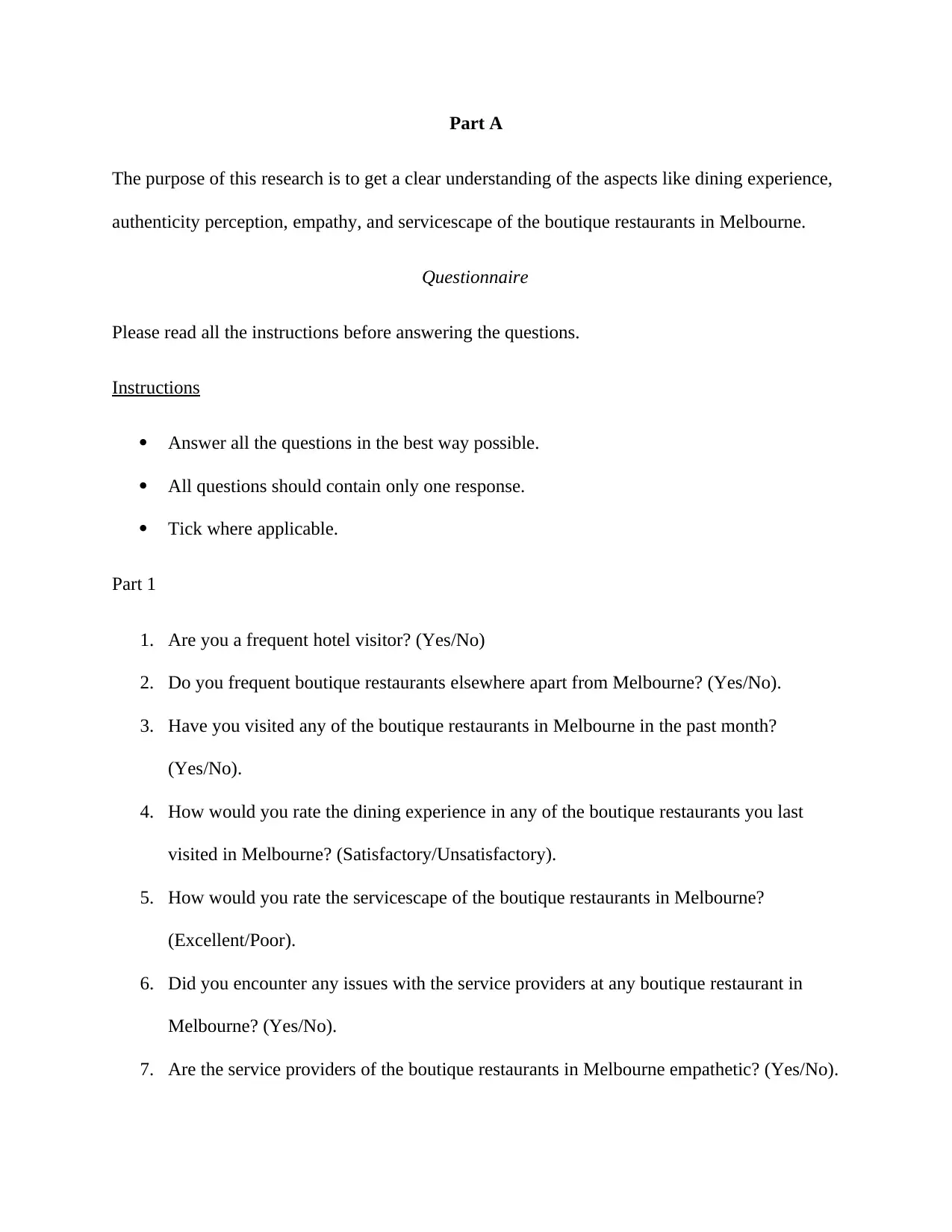
Part A
The purpose of this research is to get a clear understanding of the aspects like dining experience,
authenticity perception, empathy, and servicescape of the boutique restaurants in Melbourne.
Questionnaire
Please read all the instructions before answering the questions.
Instructions
Answer all the questions in the best way possible.
All questions should contain only one response.
Tick where applicable.
Part 1
1. Are you a frequent hotel visitor? (Yes/No)
2. Do you frequent boutique restaurants elsewhere apart from Melbourne? (Yes/No).
3. Have you visited any of the boutique restaurants in Melbourne in the past month?
(Yes/No).
4. How would you rate the dining experience in any of the boutique restaurants you last
visited in Melbourne? (Satisfactory/Unsatisfactory).
5. How would you rate the servicescape of the boutique restaurants in Melbourne?
(Excellent/Poor).
6. Did you encounter any issues with the service providers at any boutique restaurant in
Melbourne? (Yes/No).
7. Are the service providers of the boutique restaurants in Melbourne empathetic? (Yes/No).
The purpose of this research is to get a clear understanding of the aspects like dining experience,
authenticity perception, empathy, and servicescape of the boutique restaurants in Melbourne.
Questionnaire
Please read all the instructions before answering the questions.
Instructions
Answer all the questions in the best way possible.
All questions should contain only one response.
Tick where applicable.
Part 1
1. Are you a frequent hotel visitor? (Yes/No)
2. Do you frequent boutique restaurants elsewhere apart from Melbourne? (Yes/No).
3. Have you visited any of the boutique restaurants in Melbourne in the past month?
(Yes/No).
4. How would you rate the dining experience in any of the boutique restaurants you last
visited in Melbourne? (Satisfactory/Unsatisfactory).
5. How would you rate the servicescape of the boutique restaurants in Melbourne?
(Excellent/Poor).
6. Did you encounter any issues with the service providers at any boutique restaurant in
Melbourne? (Yes/No).
7. Are the service providers of the boutique restaurants in Melbourne empathetic? (Yes/No).
Paraphrase This Document
Need a fresh take? Get an instant paraphrase of this document with our AI Paraphraser
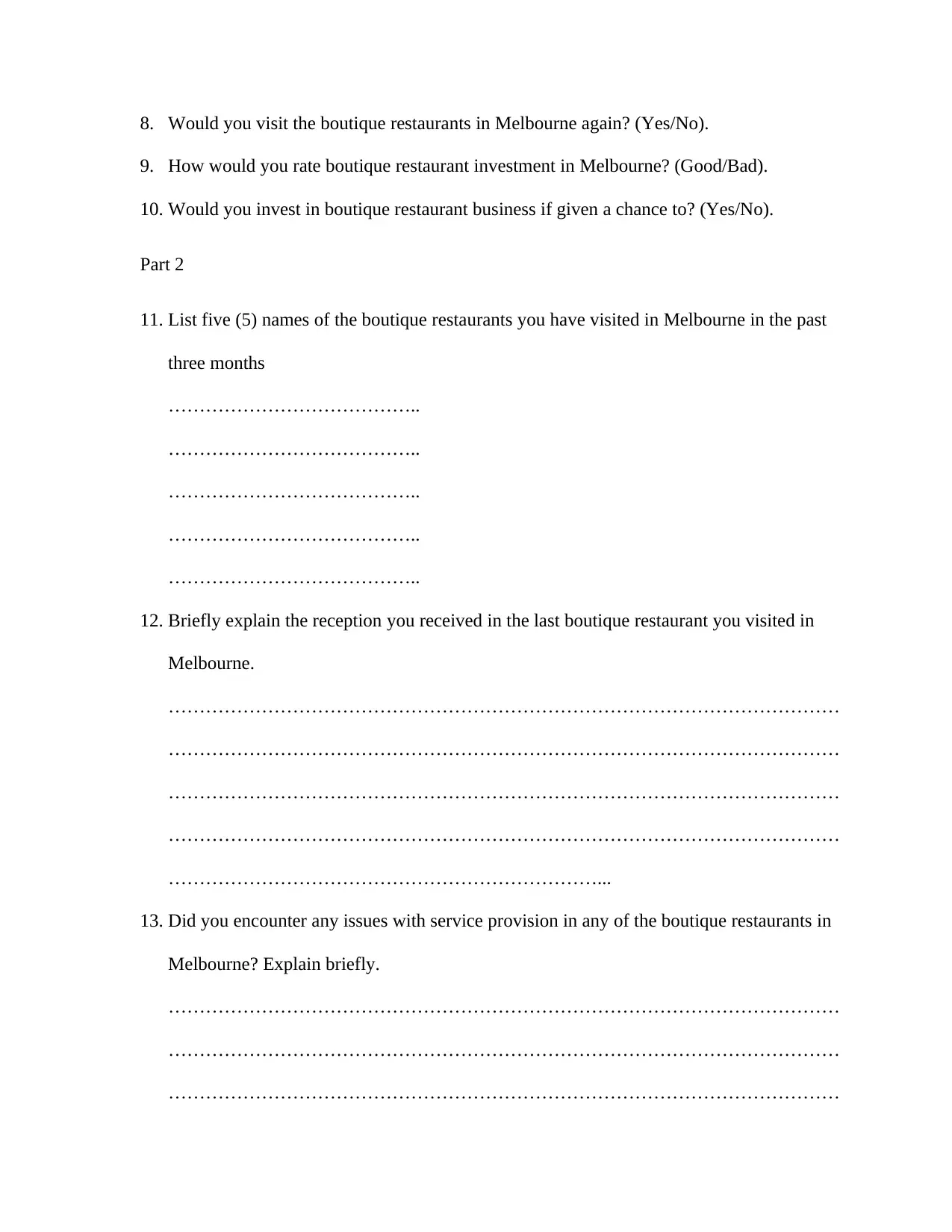
8. Would you visit the boutique restaurants in Melbourne again? (Yes/No).
9. How would you rate boutique restaurant investment in Melbourne? (Good/Bad).
10. Would you invest in boutique restaurant business if given a chance to? (Yes/No).
Part 2
11. List five (5) names of the boutique restaurants you have visited in Melbourne in the past
three months
…………………………………..
…………………………………..
…………………………………..
…………………………………..
…………………………………..
12. Briefly explain the reception you received in the last boutique restaurant you visited in
Melbourne.
………………………………………………………………………………………………
………………………………………………………………………………………………
………………………………………………………………………………………………
………………………………………………………………………………………………
……………………………………………………………...
13. Did you encounter any issues with service provision in any of the boutique restaurants in
Melbourne? Explain briefly.
………………………………………………………………………………………………
………………………………………………………………………………………………
………………………………………………………………………………………………
9. How would you rate boutique restaurant investment in Melbourne? (Good/Bad).
10. Would you invest in boutique restaurant business if given a chance to? (Yes/No).
Part 2
11. List five (5) names of the boutique restaurants you have visited in Melbourne in the past
three months
…………………………………..
…………………………………..
…………………………………..
…………………………………..
…………………………………..
12. Briefly explain the reception you received in the last boutique restaurant you visited in
Melbourne.
………………………………………………………………………………………………
………………………………………………………………………………………………
………………………………………………………………………………………………
………………………………………………………………………………………………
……………………………………………………………...
13. Did you encounter any issues with service provision in any of the boutique restaurants in
Melbourne? Explain briefly.
………………………………………………………………………………………………
………………………………………………………………………………………………
………………………………………………………………………………………………
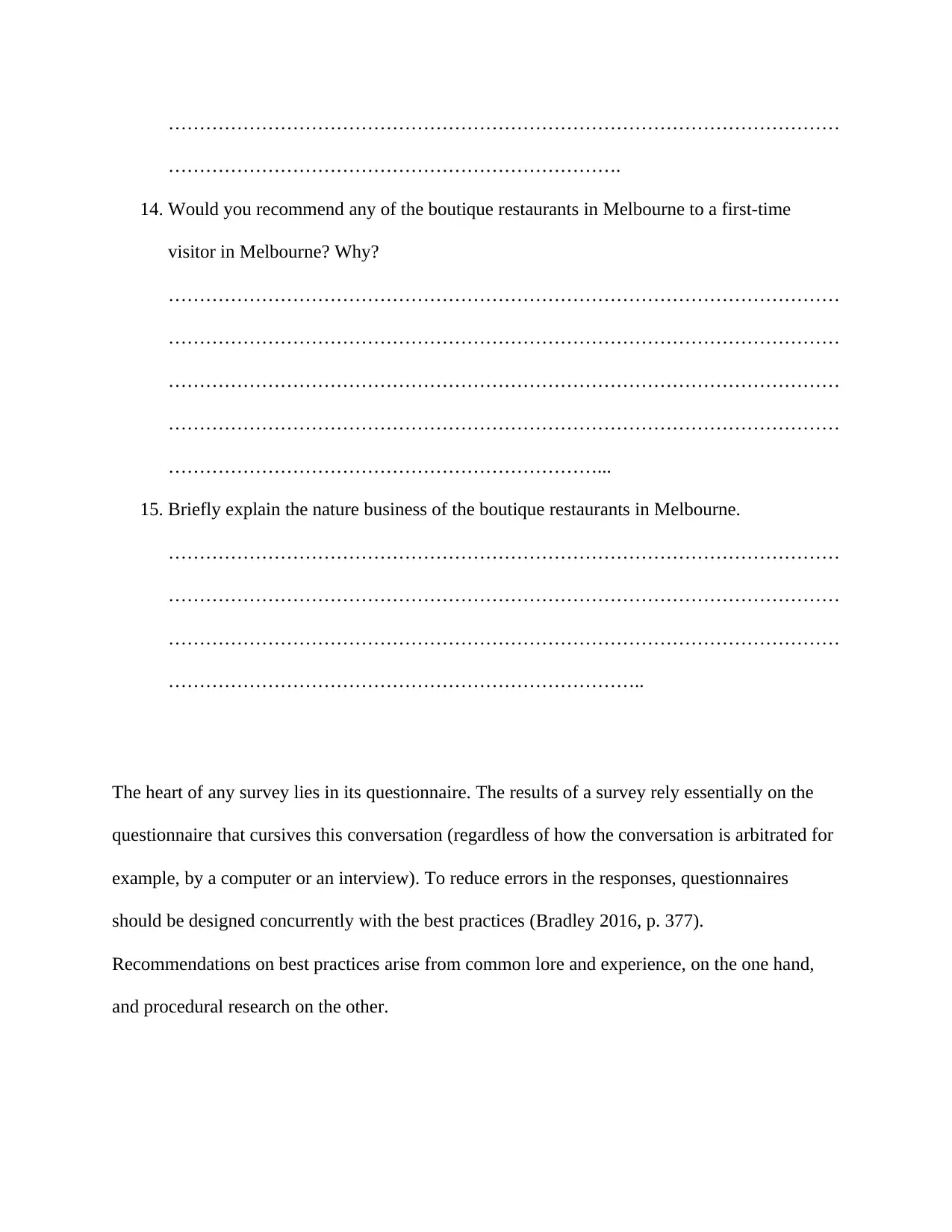
………………………………………………………………………………………………
……………………………………………………………….
14. Would you recommend any of the boutique restaurants in Melbourne to a first-time
visitor in Melbourne? Why?
………………………………………………………………………………………………
………………………………………………………………………………………………
………………………………………………………………………………………………
………………………………………………………………………………………………
……………………………………………………………...
15. Briefly explain the nature business of the boutique restaurants in Melbourne.
………………………………………………………………………………………………
………………………………………………………………………………………………
………………………………………………………………………………………………
…………………………………………………………………..
The heart of any survey lies in its questionnaire. The results of a survey rely essentially on the
questionnaire that cursives this conversation (regardless of how the conversation is arbitrated for
example, by a computer or an interview). To reduce errors in the responses, questionnaires
should be designed concurrently with the best practices (Bradley 2016, p. 377).
Recommendations on best practices arise from common lore and experience, on the one hand,
and procedural research on the other.
……………………………………………………………….
14. Would you recommend any of the boutique restaurants in Melbourne to a first-time
visitor in Melbourne? Why?
………………………………………………………………………………………………
………………………………………………………………………………………………
………………………………………………………………………………………………
………………………………………………………………………………………………
……………………………………………………………...
15. Briefly explain the nature business of the boutique restaurants in Melbourne.
………………………………………………………………………………………………
………………………………………………………………………………………………
………………………………………………………………………………………………
…………………………………………………………………..
The heart of any survey lies in its questionnaire. The results of a survey rely essentially on the
questionnaire that cursives this conversation (regardless of how the conversation is arbitrated for
example, by a computer or an interview). To reduce errors in the responses, questionnaires
should be designed concurrently with the best practices (Bradley 2016, p. 377).
Recommendations on best practices arise from common lore and experience, on the one hand,
and procedural research on the other.
⊘ This is a preview!⊘
Do you want full access?
Subscribe today to unlock all pages.

Trusted by 1+ million students worldwide
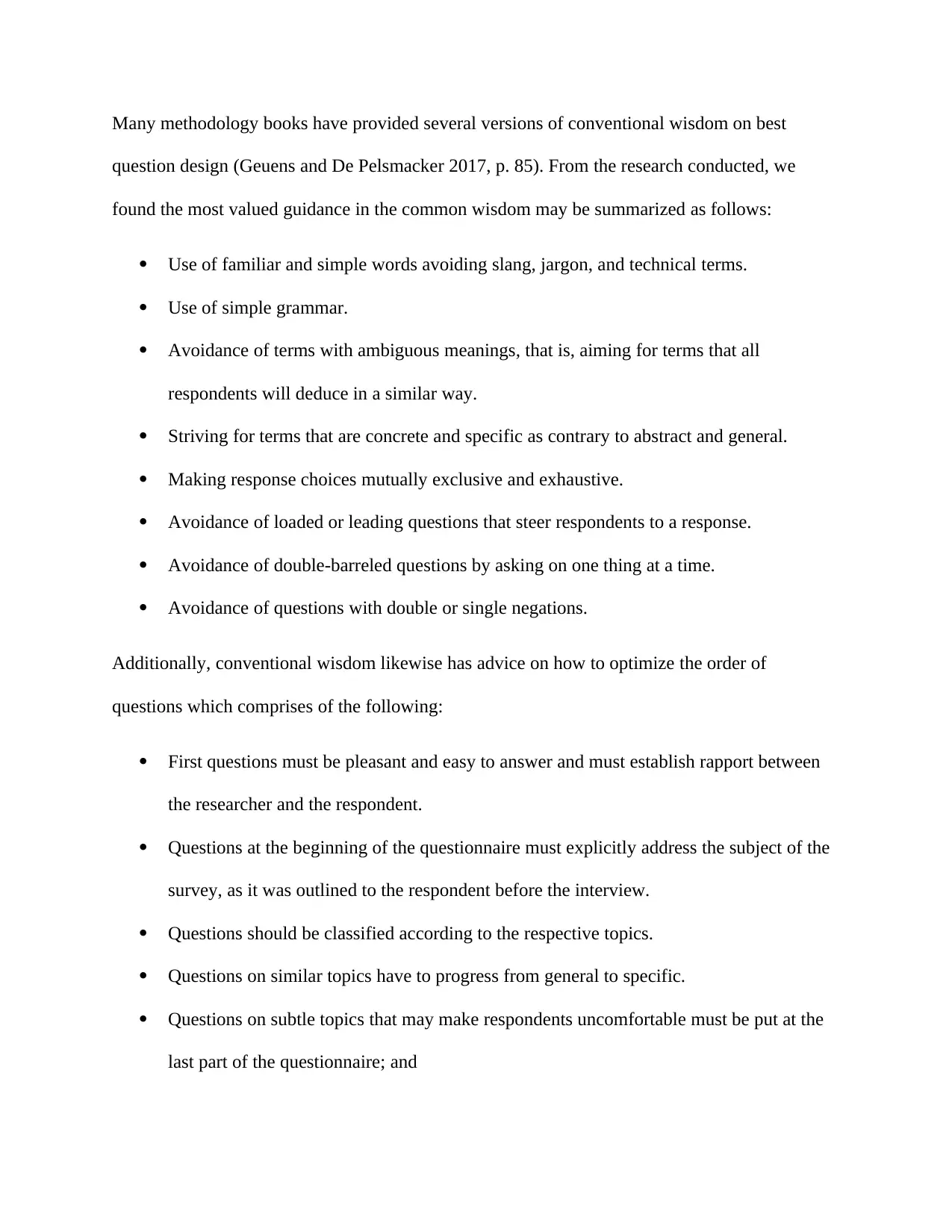
Many methodology books have provided several versions of conventional wisdom on best
question design (Geuens and De Pelsmacker 2017, p. 85). From the research conducted, we
found the most valued guidance in the common wisdom may be summarized as follows:
Use of familiar and simple words avoiding slang, jargon, and technical terms.
Use of simple grammar.
Avoidance of terms with ambiguous meanings, that is, aiming for terms that all
respondents will deduce in a similar way.
Striving for terms that are concrete and specific as contrary to abstract and general.
Making response choices mutually exclusive and exhaustive.
Avoidance of loaded or leading questions that steer respondents to a response.
Avoidance of double-barreled questions by asking on one thing at a time.
Avoidance of questions with double or single negations.
Additionally, conventional wisdom likewise has advice on how to optimize the order of
questions which comprises of the following:
First questions must be pleasant and easy to answer and must establish rapport between
the researcher and the respondent.
Questions at the beginning of the questionnaire must explicitly address the subject of the
survey, as it was outlined to the respondent before the interview.
Questions should be classified according to the respective topics.
Questions on similar topics have to progress from general to specific.
Questions on subtle topics that may make respondents uncomfortable must be put at the
last part of the questionnaire; and
question design (Geuens and De Pelsmacker 2017, p. 85). From the research conducted, we
found the most valued guidance in the common wisdom may be summarized as follows:
Use of familiar and simple words avoiding slang, jargon, and technical terms.
Use of simple grammar.
Avoidance of terms with ambiguous meanings, that is, aiming for terms that all
respondents will deduce in a similar way.
Striving for terms that are concrete and specific as contrary to abstract and general.
Making response choices mutually exclusive and exhaustive.
Avoidance of loaded or leading questions that steer respondents to a response.
Avoidance of double-barreled questions by asking on one thing at a time.
Avoidance of questions with double or single negations.
Additionally, conventional wisdom likewise has advice on how to optimize the order of
questions which comprises of the following:
First questions must be pleasant and easy to answer and must establish rapport between
the researcher and the respondent.
Questions at the beginning of the questionnaire must explicitly address the subject of the
survey, as it was outlined to the respondent before the interview.
Questions should be classified according to the respective topics.
Questions on similar topics have to progress from general to specific.
Questions on subtle topics that may make respondents uncomfortable must be put at the
last part of the questionnaire; and
Paraphrase This Document
Need a fresh take? Get an instant paraphrase of this document with our AI Paraphraser
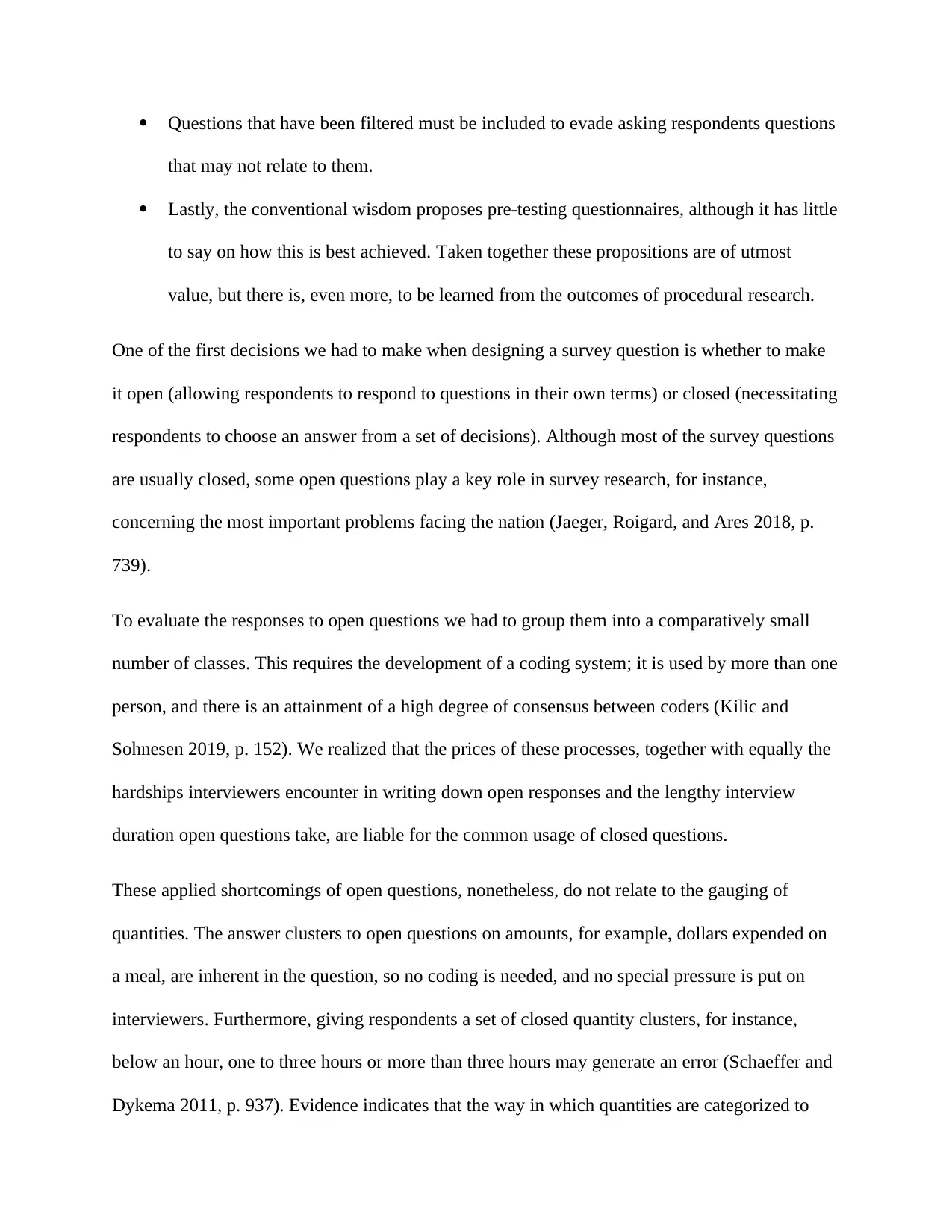
Questions that have been filtered must be included to evade asking respondents questions
that may not relate to them.
Lastly, the conventional wisdom proposes pre-testing questionnaires, although it has little
to say on how this is best achieved. Taken together these propositions are of utmost
value, but there is, even more, to be learned from the outcomes of procedural research.
One of the first decisions we had to make when designing a survey question is whether to make
it open (allowing respondents to respond to questions in their own terms) or closed (necessitating
respondents to choose an answer from a set of decisions). Although most of the survey questions
are usually closed, some open questions play a key role in survey research, for instance,
concerning the most important problems facing the nation (Jaeger, Roigard, and Ares 2018, p.
739).
To evaluate the responses to open questions we had to group them into a comparatively small
number of classes. This requires the development of a coding system; it is used by more than one
person, and there is an attainment of a high degree of consensus between coders (Kilic and
Sohnesen 2019, p. 152). We realized that the prices of these processes, together with equally the
hardships interviewers encounter in writing down open responses and the lengthy interview
duration open questions take, are liable for the common usage of closed questions.
These applied shortcomings of open questions, nonetheless, do not relate to the gauging of
quantities. The answer clusters to open questions on amounts, for example, dollars expended on
a meal, are inherent in the question, so no coding is needed, and no special pressure is put on
interviewers. Furthermore, giving respondents a set of closed quantity clusters, for instance,
below an hour, one to three hours or more than three hours may generate an error (Schaeffer and
Dykema 2011, p. 937). Evidence indicates that the way in which quantities are categorized to
that may not relate to them.
Lastly, the conventional wisdom proposes pre-testing questionnaires, although it has little
to say on how this is best achieved. Taken together these propositions are of utmost
value, but there is, even more, to be learned from the outcomes of procedural research.
One of the first decisions we had to make when designing a survey question is whether to make
it open (allowing respondents to respond to questions in their own terms) or closed (necessitating
respondents to choose an answer from a set of decisions). Although most of the survey questions
are usually closed, some open questions play a key role in survey research, for instance,
concerning the most important problems facing the nation (Jaeger, Roigard, and Ares 2018, p.
739).
To evaluate the responses to open questions we had to group them into a comparatively small
number of classes. This requires the development of a coding system; it is used by more than one
person, and there is an attainment of a high degree of consensus between coders (Kilic and
Sohnesen 2019, p. 152). We realized that the prices of these processes, together with equally the
hardships interviewers encounter in writing down open responses and the lengthy interview
duration open questions take, are liable for the common usage of closed questions.
These applied shortcomings of open questions, nonetheless, do not relate to the gauging of
quantities. The answer clusters to open questions on amounts, for example, dollars expended on
a meal, are inherent in the question, so no coding is needed, and no special pressure is put on
interviewers. Furthermore, giving respondents a set of closed quantity clusters, for instance,
below an hour, one to three hours or more than three hours may generate an error (Schaeffer and
Dykema 2011, p. 937). Evidence indicates that the way in which quantities are categorized to
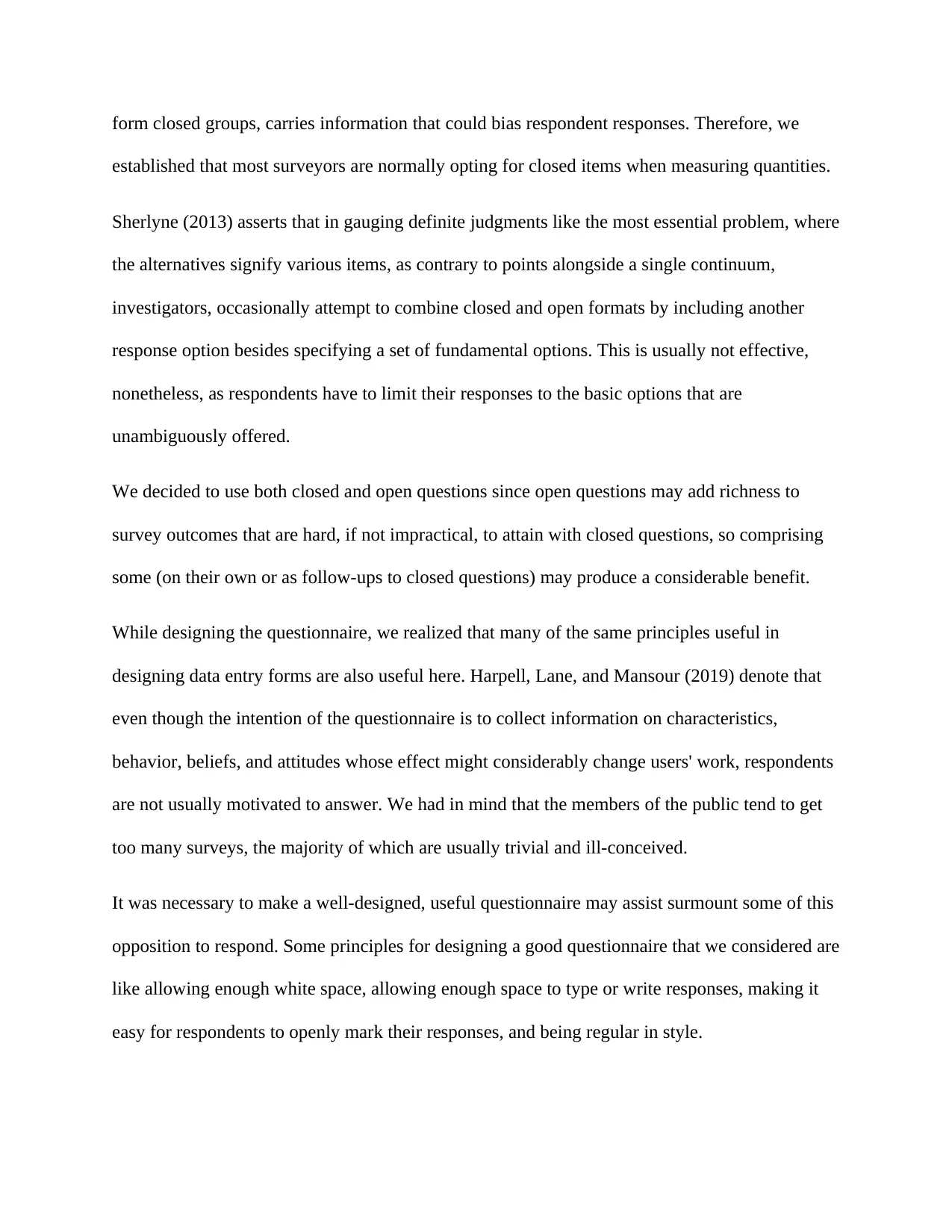
form closed groups, carries information that could bias respondent responses. Therefore, we
established that most surveyors are normally opting for closed items when measuring quantities.
Sherlyne (2013) asserts that in gauging definite judgments like the most essential problem, where
the alternatives signify various items, as contrary to points alongside a single continuum,
investigators, occasionally attempt to combine closed and open formats by including another
response option besides specifying a set of fundamental options. This is usually not effective,
nonetheless, as respondents have to limit their responses to the basic options that are
unambiguously offered.
We decided to use both closed and open questions since open questions may add richness to
survey outcomes that are hard, if not impractical, to attain with closed questions, so comprising
some (on their own or as follow-ups to closed questions) may produce a considerable benefit.
While designing the questionnaire, we realized that many of the same principles useful in
designing data entry forms are also useful here. Harpell, Lane, and Mansour (2019) denote that
even though the intention of the questionnaire is to collect information on characteristics,
behavior, beliefs, and attitudes whose effect might considerably change users' work, respondents
are not usually motivated to answer. We had in mind that the members of the public tend to get
too many surveys, the majority of which are usually trivial and ill-conceived.
It was necessary to make a well-designed, useful questionnaire may assist surmount some of this
opposition to respond. Some principles for designing a good questionnaire that we considered are
like allowing enough white space, allowing enough space to type or write responses, making it
easy for respondents to openly mark their responses, and being regular in style.
established that most surveyors are normally opting for closed items when measuring quantities.
Sherlyne (2013) asserts that in gauging definite judgments like the most essential problem, where
the alternatives signify various items, as contrary to points alongside a single continuum,
investigators, occasionally attempt to combine closed and open formats by including another
response option besides specifying a set of fundamental options. This is usually not effective,
nonetheless, as respondents have to limit their responses to the basic options that are
unambiguously offered.
We decided to use both closed and open questions since open questions may add richness to
survey outcomes that are hard, if not impractical, to attain with closed questions, so comprising
some (on their own or as follow-ups to closed questions) may produce a considerable benefit.
While designing the questionnaire, we realized that many of the same principles useful in
designing data entry forms are also useful here. Harpell, Lane, and Mansour (2019) denote that
even though the intention of the questionnaire is to collect information on characteristics,
behavior, beliefs, and attitudes whose effect might considerably change users' work, respondents
are not usually motivated to answer. We had in mind that the members of the public tend to get
too many surveys, the majority of which are usually trivial and ill-conceived.
It was necessary to make a well-designed, useful questionnaire may assist surmount some of this
opposition to respond. Some principles for designing a good questionnaire that we considered are
like allowing enough white space, allowing enough space to type or write responses, making it
easy for respondents to openly mark their responses, and being regular in style.
⊘ This is a preview!⊘
Do you want full access?
Subscribe today to unlock all pages.

Trusted by 1+ million students worldwide
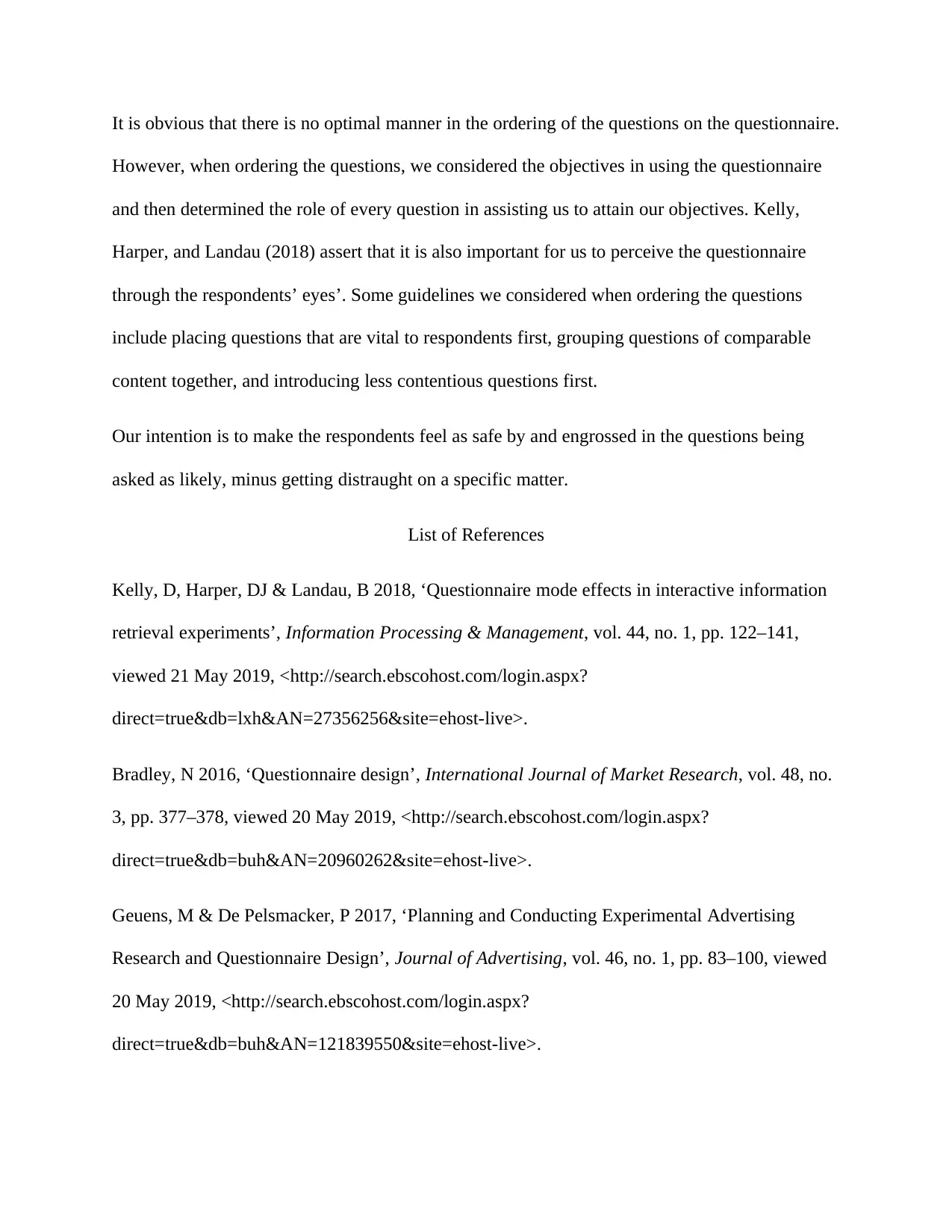
It is obvious that there is no optimal manner in the ordering of the questions on the questionnaire.
However, when ordering the questions, we considered the objectives in using the questionnaire
and then determined the role of every question in assisting us to attain our objectives. Kelly,
Harper, and Landau (2018) assert that it is also important for us to perceive the questionnaire
through the respondents’ eyes’. Some guidelines we considered when ordering the questions
include placing questions that are vital to respondents first, grouping questions of comparable
content together, and introducing less contentious questions first.
Our intention is to make the respondents feel as safe by and engrossed in the questions being
asked as likely, minus getting distraught on a specific matter.
List of References
Kelly, D, Harper, DJ & Landau, B 2018, ‘Questionnaire mode effects in interactive information
retrieval experiments’, Information Processing & Management, vol. 44, no. 1, pp. 122–141,
viewed 21 May 2019, <http://search.ebscohost.com/login.aspx?
direct=true&db=lxh&AN=27356256&site=ehost-live>.
Bradley, N 2016, ‘Questionnaire design’, International Journal of Market Research, vol. 48, no.
3, pp. 377–378, viewed 20 May 2019, <http://search.ebscohost.com/login.aspx?
direct=true&db=buh&AN=20960262&site=ehost-live>.
Geuens, M & De Pelsmacker, P 2017, ‘Planning and Conducting Experimental Advertising
Research and Questionnaire Design’, Journal of Advertising, vol. 46, no. 1, pp. 83–100, viewed
20 May 2019, <http://search.ebscohost.com/login.aspx?
direct=true&db=buh&AN=121839550&site=ehost-live>.
However, when ordering the questions, we considered the objectives in using the questionnaire
and then determined the role of every question in assisting us to attain our objectives. Kelly,
Harper, and Landau (2018) assert that it is also important for us to perceive the questionnaire
through the respondents’ eyes’. Some guidelines we considered when ordering the questions
include placing questions that are vital to respondents first, grouping questions of comparable
content together, and introducing less contentious questions first.
Our intention is to make the respondents feel as safe by and engrossed in the questions being
asked as likely, minus getting distraught on a specific matter.
List of References
Kelly, D, Harper, DJ & Landau, B 2018, ‘Questionnaire mode effects in interactive information
retrieval experiments’, Information Processing & Management, vol. 44, no. 1, pp. 122–141,
viewed 21 May 2019, <http://search.ebscohost.com/login.aspx?
direct=true&db=lxh&AN=27356256&site=ehost-live>.
Bradley, N 2016, ‘Questionnaire design’, International Journal of Market Research, vol. 48, no.
3, pp. 377–378, viewed 20 May 2019, <http://search.ebscohost.com/login.aspx?
direct=true&db=buh&AN=20960262&site=ehost-live>.
Geuens, M & De Pelsmacker, P 2017, ‘Planning and Conducting Experimental Advertising
Research and Questionnaire Design’, Journal of Advertising, vol. 46, no. 1, pp. 83–100, viewed
20 May 2019, <http://search.ebscohost.com/login.aspx?
direct=true&db=buh&AN=121839550&site=ehost-live>.
Paraphrase This Document
Need a fresh take? Get an instant paraphrase of this document with our AI Paraphraser
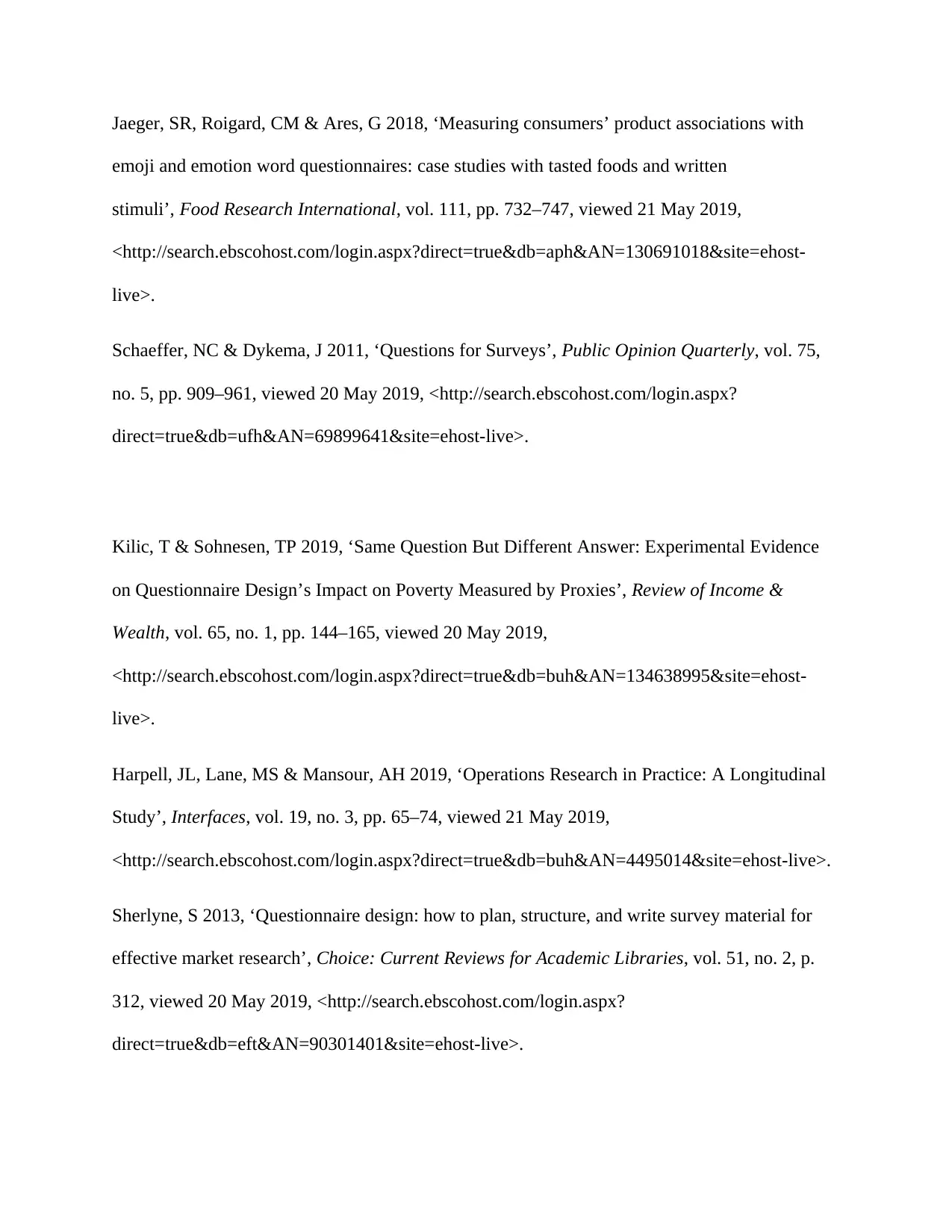
Jaeger, SR, Roigard, CM & Ares, G 2018, ‘Measuring consumers’ product associations with
emoji and emotion word questionnaires: case studies with tasted foods and written
stimuli’, Food Research International, vol. 111, pp. 732–747, viewed 21 May 2019,
<http://search.ebscohost.com/login.aspx?direct=true&db=aph&AN=130691018&site=ehost-
live>.
Schaeffer, NC & Dykema, J 2011, ‘Questions for Surveys’, Public Opinion Quarterly, vol. 75,
no. 5, pp. 909–961, viewed 20 May 2019, <http://search.ebscohost.com/login.aspx?
direct=true&db=ufh&AN=69899641&site=ehost-live>.
Kilic, T & Sohnesen, TP 2019, ‘Same Question But Different Answer: Experimental Evidence
on Questionnaire Design’s Impact on Poverty Measured by Proxies’, Review of Income &
Wealth, vol. 65, no. 1, pp. 144–165, viewed 20 May 2019,
<http://search.ebscohost.com/login.aspx?direct=true&db=buh&AN=134638995&site=ehost-
live>.
Harpell, JL, Lane, MS & Mansour, AH 2019, ‘Operations Research in Practice: A Longitudinal
Study’, Interfaces, vol. 19, no. 3, pp. 65–74, viewed 21 May 2019,
<http://search.ebscohost.com/login.aspx?direct=true&db=buh&AN=4495014&site=ehost-live>.
Sherlyne, S 2013, ‘Questionnaire design: how to plan, structure, and write survey material for
effective market research’, Choice: Current Reviews for Academic Libraries, vol. 51, no. 2, p.
312, viewed 20 May 2019, <http://search.ebscohost.com/login.aspx?
direct=true&db=eft&AN=90301401&site=ehost-live>.
emoji and emotion word questionnaires: case studies with tasted foods and written
stimuli’, Food Research International, vol. 111, pp. 732–747, viewed 21 May 2019,
<http://search.ebscohost.com/login.aspx?direct=true&db=aph&AN=130691018&site=ehost-
live>.
Schaeffer, NC & Dykema, J 2011, ‘Questions for Surveys’, Public Opinion Quarterly, vol. 75,
no. 5, pp. 909–961, viewed 20 May 2019, <http://search.ebscohost.com/login.aspx?
direct=true&db=ufh&AN=69899641&site=ehost-live>.
Kilic, T & Sohnesen, TP 2019, ‘Same Question But Different Answer: Experimental Evidence
on Questionnaire Design’s Impact on Poverty Measured by Proxies’, Review of Income &
Wealth, vol. 65, no. 1, pp. 144–165, viewed 20 May 2019,
<http://search.ebscohost.com/login.aspx?direct=true&db=buh&AN=134638995&site=ehost-
live>.
Harpell, JL, Lane, MS & Mansour, AH 2019, ‘Operations Research in Practice: A Longitudinal
Study’, Interfaces, vol. 19, no. 3, pp. 65–74, viewed 21 May 2019,
<http://search.ebscohost.com/login.aspx?direct=true&db=buh&AN=4495014&site=ehost-live>.
Sherlyne, S 2013, ‘Questionnaire design: how to plan, structure, and write survey material for
effective market research’, Choice: Current Reviews for Academic Libraries, vol. 51, no. 2, p.
312, viewed 20 May 2019, <http://search.ebscohost.com/login.aspx?
direct=true&db=eft&AN=90301401&site=ehost-live>.
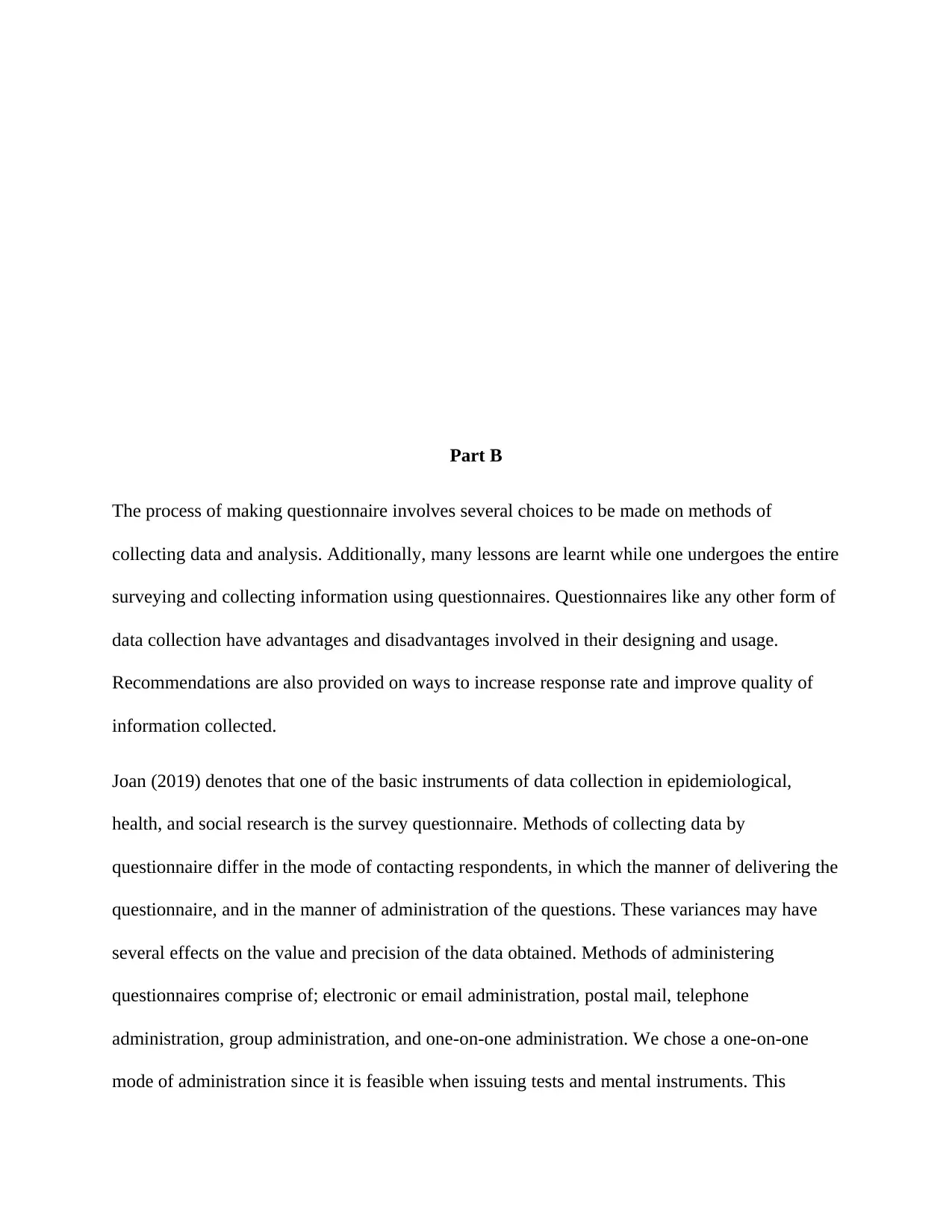
Part B
The process of making questionnaire involves several choices to be made on methods of
collecting data and analysis. Additionally, many lessons are learnt while one undergoes the entire
surveying and collecting information using questionnaires. Questionnaires like any other form of
data collection have advantages and disadvantages involved in their designing and usage.
Recommendations are also provided on ways to increase response rate and improve quality of
information collected.
Joan (2019) denotes that one of the basic instruments of data collection in epidemiological,
health, and social research is the survey questionnaire. Methods of collecting data by
questionnaire differ in the mode of contacting respondents, in which the manner of delivering the
questionnaire, and in the manner of administration of the questions. These variances may have
several effects on the value and precision of the data obtained. Methods of administering
questionnaires comprise of; electronic or email administration, postal mail, telephone
administration, group administration, and one-on-one administration. We chose a one-on-one
mode of administration since it is feasible when issuing tests and mental instruments. This
The process of making questionnaire involves several choices to be made on methods of
collecting data and analysis. Additionally, many lessons are learnt while one undergoes the entire
surveying and collecting information using questionnaires. Questionnaires like any other form of
data collection have advantages and disadvantages involved in their designing and usage.
Recommendations are also provided on ways to increase response rate and improve quality of
information collected.
Joan (2019) denotes that one of the basic instruments of data collection in epidemiological,
health, and social research is the survey questionnaire. Methods of collecting data by
questionnaire differ in the mode of contacting respondents, in which the manner of delivering the
questionnaire, and in the manner of administration of the questions. These variances may have
several effects on the value and precision of the data obtained. Methods of administering
questionnaires comprise of; electronic or email administration, postal mail, telephone
administration, group administration, and one-on-one administration. We chose a one-on-one
mode of administration since it is feasible when issuing tests and mental instruments. This
⊘ This is a preview!⊘
Do you want full access?
Subscribe today to unlock all pages.

Trusted by 1+ million students worldwide
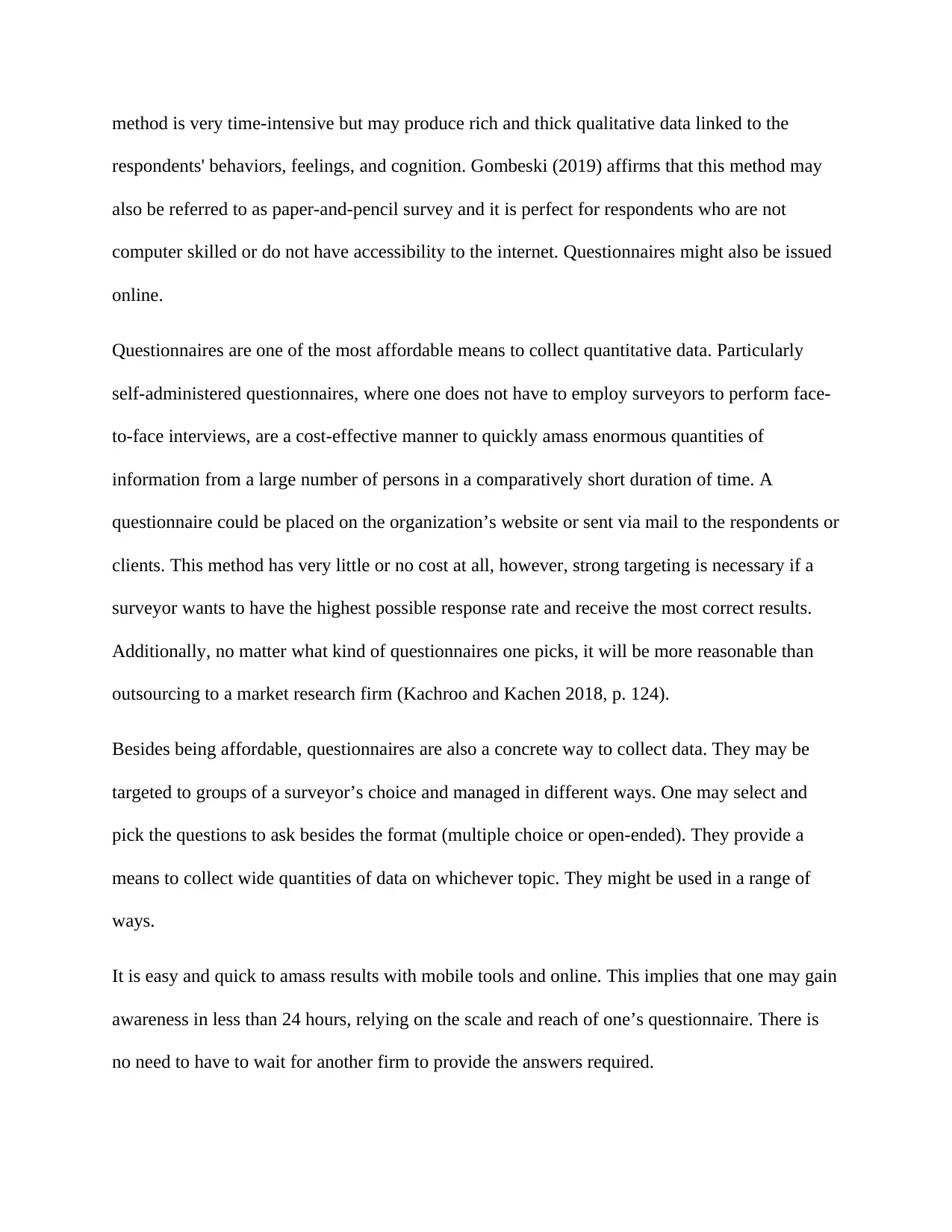
method is very time-intensive but may produce rich and thick qualitative data linked to the
respondents' behaviors, feelings, and cognition. Gombeski (2019) affirms that this method may
also be referred to as paper-and-pencil survey and it is perfect for respondents who are not
computer skilled or do not have accessibility to the internet. Questionnaires might also be issued
online.
Questionnaires are one of the most affordable means to collect quantitative data. Particularly
self-administered questionnaires, where one does not have to employ surveyors to perform face-
to-face interviews, are a cost-effective manner to quickly amass enormous quantities of
information from a large number of persons in a comparatively short duration of time. A
questionnaire could be placed on the organization’s website or sent via mail to the respondents or
clients. This method has very little or no cost at all, however, strong targeting is necessary if a
surveyor wants to have the highest possible response rate and receive the most correct results.
Additionally, no matter what kind of questionnaires one picks, it will be more reasonable than
outsourcing to a market research firm (Kachroo and Kachen 2018, p. 124).
Besides being affordable, questionnaires are also a concrete way to collect data. They may be
targeted to groups of a surveyor’s choice and managed in different ways. One may select and
pick the questions to ask besides the format (multiple choice or open-ended). They provide a
means to collect wide quantities of data on whichever topic. They might be used in a range of
ways.
It is easy and quick to amass results with mobile tools and online. This implies that one may gain
awareness in less than 24 hours, relying on the scale and reach of one’s questionnaire. There is
no need to have to wait for another firm to provide the answers required.
respondents' behaviors, feelings, and cognition. Gombeski (2019) affirms that this method may
also be referred to as paper-and-pencil survey and it is perfect for respondents who are not
computer skilled or do not have accessibility to the internet. Questionnaires might also be issued
online.
Questionnaires are one of the most affordable means to collect quantitative data. Particularly
self-administered questionnaires, where one does not have to employ surveyors to perform face-
to-face interviews, are a cost-effective manner to quickly amass enormous quantities of
information from a large number of persons in a comparatively short duration of time. A
questionnaire could be placed on the organization’s website or sent via mail to the respondents or
clients. This method has very little or no cost at all, however, strong targeting is necessary if a
surveyor wants to have the highest possible response rate and receive the most correct results.
Additionally, no matter what kind of questionnaires one picks, it will be more reasonable than
outsourcing to a market research firm (Kachroo and Kachen 2018, p. 124).
Besides being affordable, questionnaires are also a concrete way to collect data. They may be
targeted to groups of a surveyor’s choice and managed in different ways. One may select and
pick the questions to ask besides the format (multiple choice or open-ended). They provide a
means to collect wide quantities of data on whichever topic. They might be used in a range of
ways.
It is easy and quick to amass results with mobile tools and online. This implies that one may gain
awareness in less than 24 hours, relying on the scale and reach of one’s questionnaire. There is
no need to have to wait for another firm to provide the answers required.
Paraphrase This Document
Need a fresh take? Get an instant paraphrase of this document with our AI Paraphraser
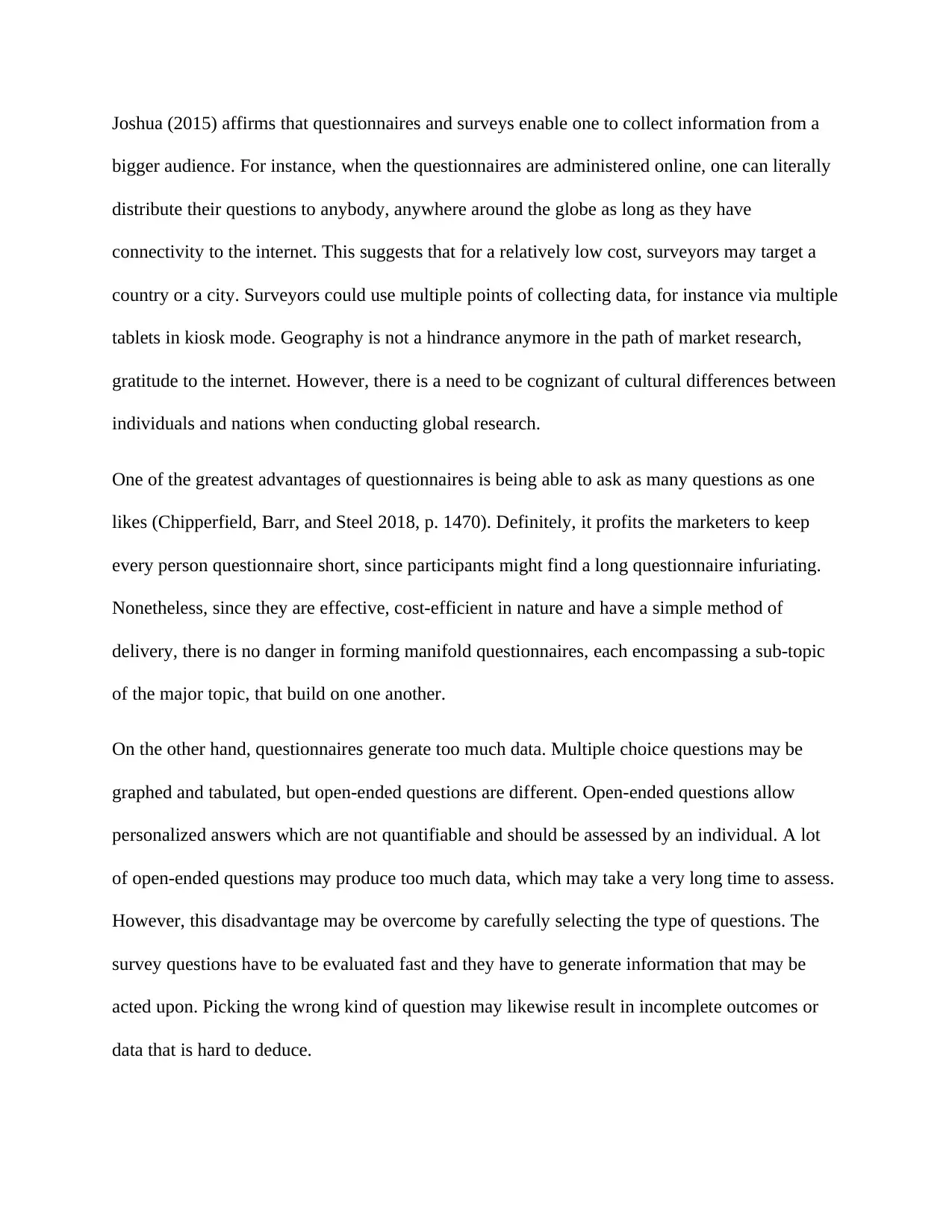
Joshua (2015) affirms that questionnaires and surveys enable one to collect information from a
bigger audience. For instance, when the questionnaires are administered online, one can literally
distribute their questions to anybody, anywhere around the globe as long as they have
connectivity to the internet. This suggests that for a relatively low cost, surveyors may target a
country or a city. Surveyors could use multiple points of collecting data, for instance via multiple
tablets in kiosk mode. Geography is not a hindrance anymore in the path of market research,
gratitude to the internet. However, there is a need to be cognizant of cultural differences between
individuals and nations when conducting global research.
One of the greatest advantages of questionnaires is being able to ask as many questions as one
likes (Chipperfield, Barr, and Steel 2018, p. 1470). Definitely, it profits the marketers to keep
every person questionnaire short, since participants might find a long questionnaire infuriating.
Nonetheless, since they are effective, cost-efficient in nature and have a simple method of
delivery, there is no danger in forming manifold questionnaires, each encompassing a sub-topic
of the major topic, that build on one another.
On the other hand, questionnaires generate too much data. Multiple choice questions may be
graphed and tabulated, but open-ended questions are different. Open-ended questions allow
personalized answers which are not quantifiable and should be assessed by an individual. A lot
of open-ended questions may produce too much data, which may take a very long time to assess.
However, this disadvantage may be overcome by carefully selecting the type of questions. The
survey questions have to be evaluated fast and they have to generate information that may be
acted upon. Picking the wrong kind of question may likewise result in incomplete outcomes or
data that is hard to deduce.
bigger audience. For instance, when the questionnaires are administered online, one can literally
distribute their questions to anybody, anywhere around the globe as long as they have
connectivity to the internet. This suggests that for a relatively low cost, surveyors may target a
country or a city. Surveyors could use multiple points of collecting data, for instance via multiple
tablets in kiosk mode. Geography is not a hindrance anymore in the path of market research,
gratitude to the internet. However, there is a need to be cognizant of cultural differences between
individuals and nations when conducting global research.
One of the greatest advantages of questionnaires is being able to ask as many questions as one
likes (Chipperfield, Barr, and Steel 2018, p. 1470). Definitely, it profits the marketers to keep
every person questionnaire short, since participants might find a long questionnaire infuriating.
Nonetheless, since they are effective, cost-efficient in nature and have a simple method of
delivery, there is no danger in forming manifold questionnaires, each encompassing a sub-topic
of the major topic, that build on one another.
On the other hand, questionnaires generate too much data. Multiple choice questions may be
graphed and tabulated, but open-ended questions are different. Open-ended questions allow
personalized answers which are not quantifiable and should be assessed by an individual. A lot
of open-ended questions may produce too much data, which may take a very long time to assess.
However, this disadvantage may be overcome by carefully selecting the type of questions. The
survey questions have to be evaluated fast and they have to generate information that may be
acted upon. Picking the wrong kind of question may likewise result in incomplete outcomes or
data that is hard to deduce.
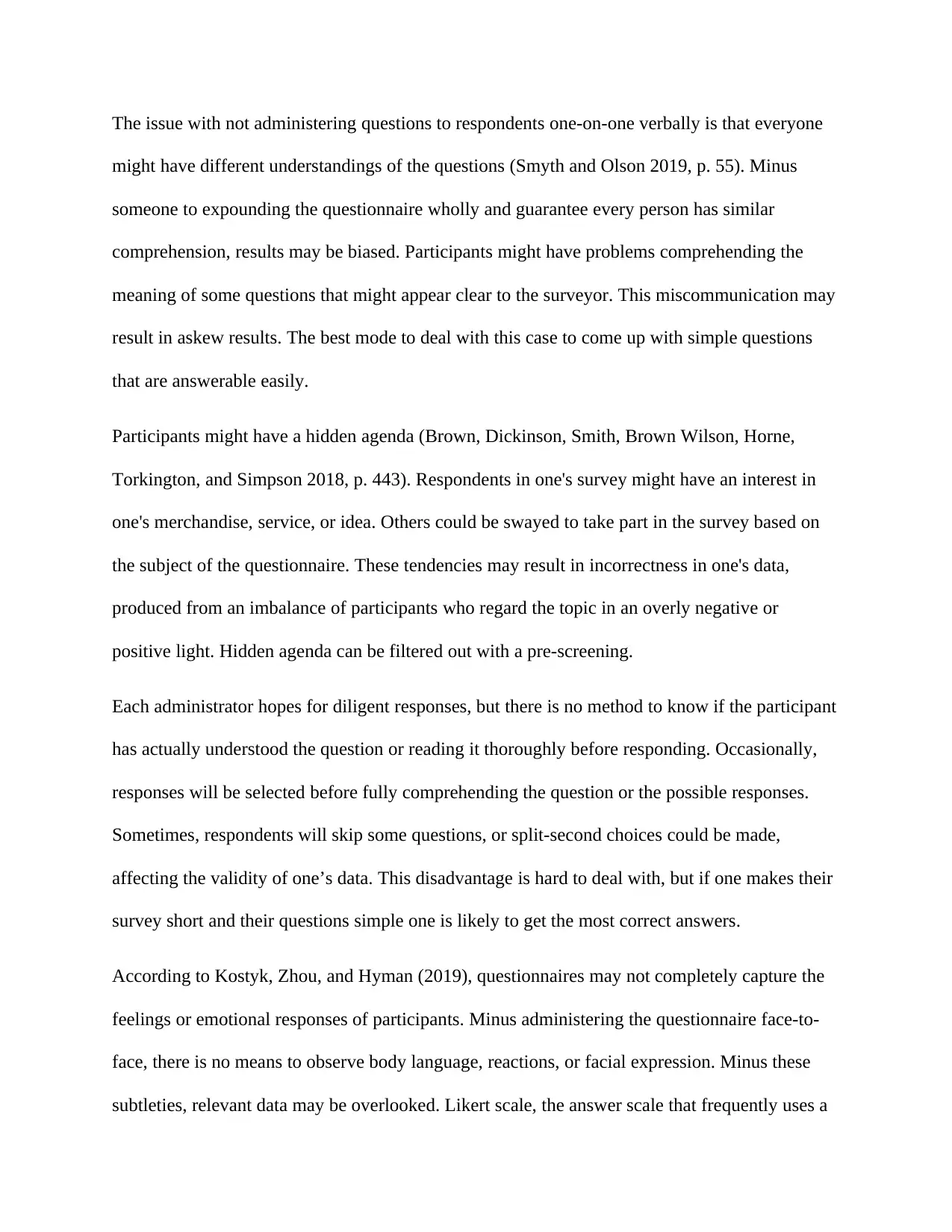
The issue with not administering questions to respondents one-on-one verbally is that everyone
might have different understandings of the questions (Smyth and Olson 2019, p. 55). Minus
someone to expounding the questionnaire wholly and guarantee every person has similar
comprehension, results may be biased. Participants might have problems comprehending the
meaning of some questions that might appear clear to the surveyor. This miscommunication may
result in askew results. The best mode to deal with this case to come up with simple questions
that are answerable easily.
Participants might have a hidden agenda (Brown, Dickinson, Smith, Brown Wilson, Horne,
Torkington, and Simpson 2018, p. 443). Respondents in one's survey might have an interest in
one's merchandise, service, or idea. Others could be swayed to take part in the survey based on
the subject of the questionnaire. These tendencies may result in incorrectness in one's data,
produced from an imbalance of participants who regard the topic in an overly negative or
positive light. Hidden agenda can be filtered out with a pre-screening.
Each administrator hopes for diligent responses, but there is no method to know if the participant
has actually understood the question or reading it thoroughly before responding. Occasionally,
responses will be selected before fully comprehending the question or the possible responses.
Sometimes, respondents will skip some questions, or split-second choices could be made,
affecting the validity of one’s data. This disadvantage is hard to deal with, but if one makes their
survey short and their questions simple one is likely to get the most correct answers.
According to Kostyk, Zhou, and Hyman (2019), questionnaires may not completely capture the
feelings or emotional responses of participants. Minus administering the questionnaire face-to-
face, there is no means to observe body language, reactions, or facial expression. Minus these
subtleties, relevant data may be overlooked. Likert scale, the answer scale that frequently uses a
might have different understandings of the questions (Smyth and Olson 2019, p. 55). Minus
someone to expounding the questionnaire wholly and guarantee every person has similar
comprehension, results may be biased. Participants might have problems comprehending the
meaning of some questions that might appear clear to the surveyor. This miscommunication may
result in askew results. The best mode to deal with this case to come up with simple questions
that are answerable easily.
Participants might have a hidden agenda (Brown, Dickinson, Smith, Brown Wilson, Horne,
Torkington, and Simpson 2018, p. 443). Respondents in one's survey might have an interest in
one's merchandise, service, or idea. Others could be swayed to take part in the survey based on
the subject of the questionnaire. These tendencies may result in incorrectness in one's data,
produced from an imbalance of participants who regard the topic in an overly negative or
positive light. Hidden agenda can be filtered out with a pre-screening.
Each administrator hopes for diligent responses, but there is no method to know if the participant
has actually understood the question or reading it thoroughly before responding. Occasionally,
responses will be selected before fully comprehending the question or the possible responses.
Sometimes, respondents will skip some questions, or split-second choices could be made,
affecting the validity of one’s data. This disadvantage is hard to deal with, but if one makes their
survey short and their questions simple one is likely to get the most correct answers.
According to Kostyk, Zhou, and Hyman (2019), questionnaires may not completely capture the
feelings or emotional responses of participants. Minus administering the questionnaire face-to-
face, there is no means to observe body language, reactions, or facial expression. Minus these
subtleties, relevant data may be overlooked. Likert scale, the answer scale that frequently uses a
⊘ This is a preview!⊘
Do you want full access?
Subscribe today to unlock all pages.

Trusted by 1+ million students worldwide
1 out of 19
Your All-in-One AI-Powered Toolkit for Academic Success.
+13062052269
info@desklib.com
Available 24*7 on WhatsApp / Email
![[object Object]](/_next/static/media/star-bottom.7253800d.svg)
Unlock your academic potential
Copyright © 2020–2025 A2Z Services. All Rights Reserved. Developed and managed by ZUCOL.


